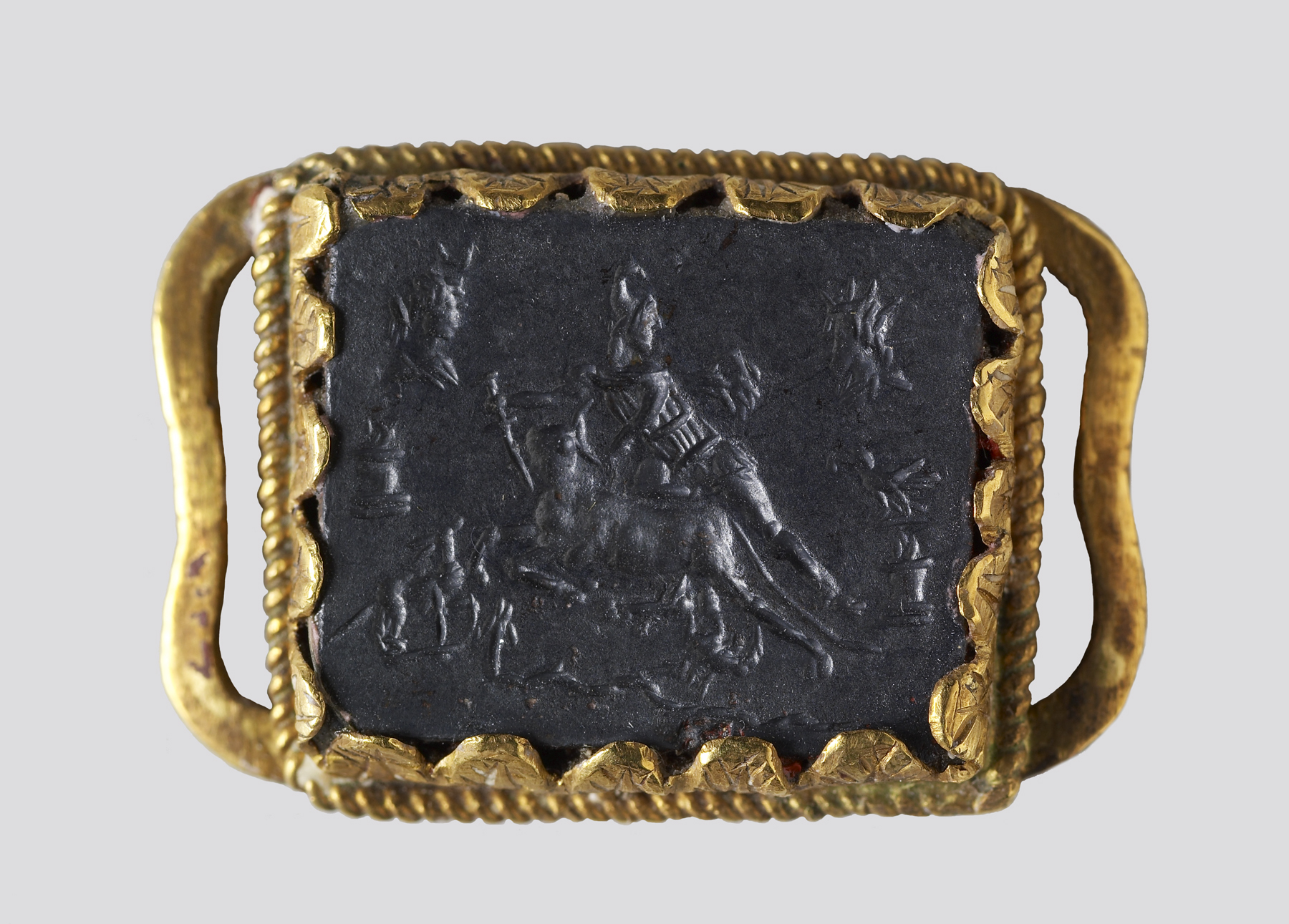Intaglio with Mithras Slaying the Bull and the God Abraxas Set in a Mount
(Roman Empire )
One side of this intaglio bears a depiction of the god Abraxas, a rooster-headed and snake-tailed Gnostic deity. He holds a whip in his right hand and a shield with “ΙΑΩ” inscribed on it in his left. On the other side of the gem is Mithras, the Persian god of light, dressed in Phrygian clothing. He looks away as he slaughters the bull with a dagger held in his right hand. In the field to the right is a radiate head, identifiable as the sun god Sol, and to the left is the head of woman with a crescent, identifiable as the moon goddess Luna. There is an altar on each side, and one of which has a raven on it. Below are a snake, scorpion, and dog.
Mithraism, a Roman mystery religion, was restricted to men and was especially popular with soldiers in Rome and on the northern frontier during the second and third centuries. According to the Persian myth, the sun god sent his messenger, the raven, to Mithras and ordered him to sacrifice the primeval white bull. At the moment of its death, the bull became the moon, and the sacrifice led to the first ears of grain and all the other creatures of earth. This scene of sacrifice, central to Roman Mithraism, is called the Tauroctony.
Inscription
Provenance
Provenance (from the French provenir, 'to come from/forth') is the chronology of the ownership, custody, or location of a historical object. Learn more about provenance at the Walters.
George Spencer, fourth Duke of Marlborough, Blenheim Palace, Oxfordshire, by 1817, by purchase [Marlborough nos. 278 and 287]; George Spencer-Churchill, fifth Duke of Marlborough, Blenheim Palace, Oxfordshire, 1817, by bequest; George Spencer-Churchill, sixth Duke of Marlborough, Blenheim Palace, Oxfordshire, 1840, by bequest; John Spencer-Churchill, seventh Duke of Marlborough, Blenheim Palace, Oxfordshire, 1857, by bequest; Sale, The Marlborough Gems, Christie, Manson & Woods, London, 28 June 1875, pp. 44 and 46, lots 278 and 287; David Bromilow, Bitteswell Hall, Leicestershire, ca. 1875, by purchase; Julia Bromilow Jary, Bitteswell Hall, Leicestershire, 1898, by bequest; Sale, The Marlborough Gems Purchased by the Late David Bromilow, esq., Christie, Manson & Woods, London, 26 June 1899, p. 50, lot 278; Henry Walters, Baltimore, 1899, by purchase [Dikran Kelekian as agent]; Sadie Jones (Mrs. Henry Walters), New York, 1931, by bequest; Joseph Brummer, Paris and New York, 1941, by purchase [Brummer inv. no. N5143a]; Walters Art Museum, 1942, by purchase.
Exhibitions
| 1947 | Early Christian and Byzantine Art. Baltimore Museum of Art, Baltimore. |
Conservation
| Date | Description | Narrative |
|---|---|---|
| Examination | Examined | |
| Examination | Examined in preparation for case retro-fit and re-installation. |
Geographies
Italy (Place of Origin)
Measurements
H: 3/4 x W: 1 1/16 x D: 3/16 in. (1.9 x 2.72 x 0.45 cm); H without elaborate setting: 1/2 x W: 11/16 x D: 1/8 in. (1.3 x 1.8 x 0.3 cm)
Credit Line
Museum purchase [formerly part of the Walters Collection], 1942
Location in Museum
Accession Number
In libraries, galleries, museums, and archives, an accession number is a unique identifier assigned to each object in the collection.
In libraries, galleries, museums, and archives, an accession number is a unique identifier assigned to each object in the collection.
42.868








